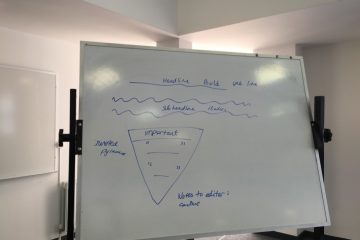I try and avoid writing about copyright too much, mainly because I don’t want to seem to harp on about it. But when there’s a lot of chatter about it in a short space of time it’s hard to avoid helping others in their quest for answers when you have the knowledge.
First off, if you’re a journalist and want to know about copyright please bookmark the What is copyright and how does it affect Irish freelances? article on Journalist.ie.
One interesting point for everyone to learn from the Journalist.ie article is: “Under Irish and international copyright law, the original author always owns the copyright to their work (whether or not they use a copyright symbol) unless the author signs their rights away to a third party.”
The Journalist.ie article entitled What to do if your copyright is infringed is also worth a read/bookmark for anyone who has published content online in any form. (Disclosure, I wrote the article for Journalist.ie).
This article includes information on what action you can take. This is (in short): send an invoice, know your rights and contact the ISP.
I’m going to bring copyright straight back to basics. If you didn’t create it and you didn’t pay for it and the person who did create it or even pay for it hasn’t said you can take it, it’s not yours.
“I didn’t realise!”
While some people do this maliciously, in many cases copyright infringement is just down to pure ignorance or innocence. People think that like a bike abandoned on a street it’s just there for the taking.
Now and again you’ll have people copying whole websites, or even copying the names of sections. This probably falls into the lazy category, and possibly downright stupid too. On the latter point, sure, most websites will have About, Contact or Sign In as part of the navigation. That’s fine, but say if you copy exactly what a competitor has and it’s an unusual combination of words, it will be noticed. It’s probably not copyright infringement but it is being unoriginal and being a lazy copycat. Nobody likes copycat.
Duplicate content in the form of entire pages cut and paste from another website is copyright infringement. Somebody is responsible for that cut and paste action and may assume the other site owner will not notice. But they usually do, and that’s when the whispering starts.
“What do you mean I can’t even copy a news story?”
If you’re writing a news story or a blog neither is it acceptable to just rewrite or reuse somebody else’s words without attributing the source (unless it’s a press release). It’s not acceptable to copy a whole article, for example, from a news website and put it on your own website with wording like Source/Courtesy of, unless you actually have permission to republish it.
There are exemptions under the Copyright and Related Rights Act, 2000 for fair use – but it’s a grey area and, I’ve been informed that even in fair dealing situations, the original copyright holder must be credited as the source.
If you’re wondering if anybody has infringed your copyright, the simplest way to check is by putting whole sentences into a search engine. You’ll be surprised with what you find. I was.
Photos have an owner too
Apart from words, photographs and imagery are forms of visual content that are impacted on by copyright. As above, they should not be used unless you have the permission to reuse them or have gained that permission through purchasing them. Photography is a profession and photographers should be paid for the reuse of their work. Some photos that appear in the press are organised by public relations companies and are free to use for these purposes. Others are taken by staff photographers or freelance photographers. In these cases people wanting to reuse such a photo should contact the publishing company or the photographer directly. It’s best to ask before just assuming anything online that doesn’t have a big Pay Now button beside it is all yours.
Other ways to pay for photos include going stock photography sites such as Getty. But please do a Google search for stock photos for other sites. Oh go on, click on that hyperlink, I had so much fun putting it together for you! A new addition to the stock photo scene is an Irish-based company called Picturk.
Options for using photos for free include doing a search on Flickr.com’s Creative Commons section (to understand more about the Creative Commons licenses see CreativeCommons.org). You can also get free stock photos by going to a site like stock.xchng, just make sure to read the small print. If you’re looking for something that is as old as the hills put aside a few hours to enjoy The Commons on Flickr.
So does that answer your questions or is there anything else I can help you with?
“There are exemptions under the Copyright and Related Rights Act, 2000 for fair use – the fair dealing provisions – whereby [a] certain re-uses subject to crediting the original source of the material is permissible. It’s usually for education or reporting current events (though you can’t re-use a photograph in this context), criticism and review. “
“There’s a grey area there and very little case law in Ireland on how much use is permitted [(so long as they credit a source)] as fair dealing. Even in fair dealing situations, the original copyright holder must be credited as the source. ”



3 Comments
Deirdre ní Dhubhghaill · January 21, 2011 at 2:12 pm
Hi Elaine
Thanks for your article. There seems to be something of a buzz around copyright here in Wexford at the moment. I attended a seminar last Wednesday night and the subject of commercial printers reusing graphic designers artwork was actually brought up by a commercial printer. Your following point was emphasised by the lecturer.
“I’m going to bring copyright straight back to basics. If you didn’t create it and you didn’t pay for it and the person who did create it or even pay for it hasn’t said you can take it, it’s not yours.”
I’d like to add to the above piece on the ‘pay and permission for it’, bit. Paying for a piece doesn’t confer copyright to the purchaser {that is a common misperception) copyright can only be transfered by carefully written permission by the original creative. Of course it’ll cost extra.
For example if a Graphic designer designs content, layout, etc, then creates the artwork for a customer to have printed. The customer buys the right to print the piece. This does not give the customer or a commercial printer permission to legally use elements of the design (for example specifically created maps) elsewhere with out permission from the original creator. In fact they are required to seek permission to use the elements in another printed piece, promotion, etc or on a website. Even if the original print customer was the creator. The printer only has permission to print the piece they received as they received it anything else must be agreed with the original creator.
Maybe it’s the simplicity of that fact that creates copyright confusion or perhaps wishful thinking on the part of the thieves.
I just don’t use the abusing print house again maybe in the future I’d sue.
Elaine Larkin · January 21, 2011 at 3:53 pm
Hi Deirdre, thanks for your comment and I think you’ve raised an important point that I wasn’t aware of myself on the copyright of artwork created by graphic designers. It’s not my area, so I’d never thought about it, which is maybe the problem with copyright infringement in general.
Thanks for adding to the piece in relation to the transference of copyright.
Tweets that mention Copyrights and copywrongs – what you need to know about stolen content | WebContent.ie blog -- Topsy.com · January 21, 2011 at 1:26 pm
[…] This post was mentioned on Twitter by Cada Media, Elaine Larkin. Elaine Larkin said: Copyrights and copywrongs – what you need to know about stolen content http://bit.ly/ghXL56 […]